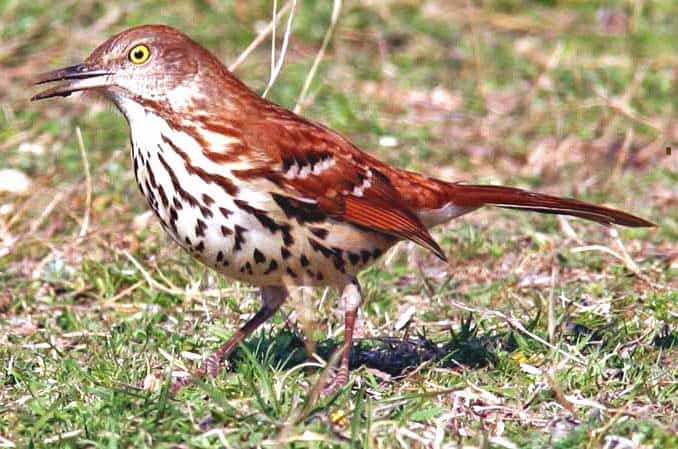University of Florida/IFAS Extension Director for Nassau County, Rebecca Jordi, answers questions about landscaping and gardening in northeast Florida.
QUESTION: Can you tell me about this medium size rust colored bird? He moves the sand around in my back yard. I think he might be looking for insects. WT
Brown Thrasher, State Bird of Georgia
JORDI: I believe you have encountered a Brown Thrasher, Toxostoma rufum. This bird is found throughout Eastern U.S. and Canada most of the central part of U.S. They are often found along the forest edges and wooded thickets.
Female thrashers will lay 3-5 eggs. Incubation takes about 2 weeks and the young birds leave the nest within 9-13 days. Both male and female thrashers share the duties of incubation and feeding the young.
The name “thrasher” may come from the bird’s habit of thrashing ground litter with its bill in a side-to-side motion which is what you were observing. Brown thrashers eat insects, mainly beetles and other arthropods, fruits and nuts. They forage for food on the ground in leaf litter below trees and shrubs. Migration is over short distances and at night. Males and females look very similar and are difficult to distinguish. Apparently, brown thrashers are superb singers, often mimicking other bird songs. Males have been known to display as many as 1,100 songs – most any female should be impressed! The Brown Thrasher is the state bird of Georgia.
QUESTION: Should I cut off the flowering stems of my agapanthus? TD

JORDI: It is not required to remove the spent flowers, but it will help conserve some of the plant’s energy. Removing old flowers is always a good gardening practice for most any flowering plant. It takes quite a bit of the plant’s energy reserves to make new seeds for future production. Since these perennials do not need to be reseeding, it would be helpful to the plant to remove the flower stalks. It is possible the plant will then put some of its energy into producing a second crop of flowers. This will allow the agapanthus to potentially provide you with another season of beauty.
There are several different cultivars of agapanthus which may or may not be available at your local garden centers or nurseries: ‘Stevie’s Wonder’, ‘Blue Heaven’, ‘Ellamae’, ‘Midnight Blue’, ‘Tinkerbell’, ‘Lilliput’, White: ‘Albus’, ‘Flore Pleno,’ double flowers, ‘Variegatus’ with striped leaves; and ‘Nanus’ a dwarf, compact form. For more complete information on agapanthus see the University of Florida’s publication.
QUESTION: I found this long black beetle with two “eyes” near its head. What is it? CP

JORDI: It could have been the adult click beetles Alaus myops or Alaus oculatus. The “eye” spot are much more pronounced on A. oculatus. This “eye” feature is most likely used to confuse potential predators. Both Florida species have a mottled pattern on the dorsal surface created by minute scales.
Many people mistakenly believe the adult and larvae to be plant pests, but the adults cause little or no damage to commercial crops or ornamental plants. The larvae however are important predators of several wood-boring pests. Craighead (1950: 185) stated the larvae of oculatus were voracious on wood borers, and during their development caged specimens each devoured more than 200 cerambycid larvae. They are most often encountered in rotting stumps of oak, cherry, and apple, whereas myops is usually found in pine stumps and logs. For more complete information check the University of Florida publication on click beetles.
___________
Rebecca L. Jordi
Nassau County Extension Director
UF/IFAS Environmental Horticulture
543350 U.S. Highway #1
Callahan, FL 32011
904-530-6351
http://nassau.ifas.ufl.edu
“We provide practical education you can trust, to help people, businesses and communities solve problems, develop skills and build a better future.”
